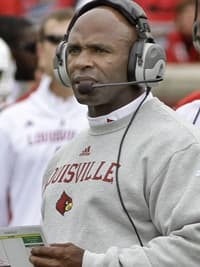Strongs decision to stay will have long-lasting effects

As I finally relaxed last week after the Charlie Strong saga ended with the good news that he was staying as the University of Louisville football coach, it suddenly hit me that this was a seminal moment in the history of UofL football.
Seminal means "strongly influencing later developments," and Charlie's decision to remain at UofL and pass up the opportunity to coach at Tennessee in the Southeastern Conference is an event that will impact Cardinals football, hopefully, forever.
Advertisement
This was more than a decision to turn down a coaching offer; that happens all the time. It was a statement that UofL is no longer a "steppingstone" to bigger and better things but a "destination," where a coach can reach the pinnacle of college football. As a result of this decision there was a collective gasp in the world of network sports and in so-called "big-time" conference offices as conventional wisdom was turned on its head. This event boosted the perception of UofL football perhaps more than any other.
As I reflect on the 100-year history of Louisville football, there seems to be six seminal moments that have brought Cardinal football fans to the point we are at today:
Med students' decision in 1912: The decision by a group of Medical School students in September 1912 to form an intramural football team and start playing other schools in the region: Football was just starting to catch on in those days, and it must have been a very zealous group of future doctors willing to form a team, buy equipment (don't forget, there were no Dick's or Sutcliffe's in those days), travel to games (no interstates or four-lane roads and very few people had cars), organize the team and plan for the game ( little was known of the rules and strategy of football at that time). In spite of those obstacles, the students persevered and first the Medical School and later UofL played football continuously until today except for brief respites during the two World Wars. Those aspiring doctors started the tradition that is Louisville football.
The hiring of Frank Camp in 1946: Camp was the first experienced football coach (high school level) hired by the university to coach football. Camp was highly successful, probably more than the administration desired, and football actually started to draw fans and bring in athletes on scholarship. Camp was a winner and introduced innovative and exciting football that attracted good players, such as Johnny Unitas, Lenny Lyles and Ernie Green. It was during Camp's tenure as coach that a dream would take shape in the hearts and minds of many that UofL could someday compete on a national level. That was verified on Jan. 1, 1958, when Louisville defeated Drake in the Sun Bowl and started the legacy that is UofL's bowl history.
The hiring of Howard Schnellenberger in 1985: "The Coach" had won a national championship (at Miami in 1983), and the vision of Bill Olsen and John Y. Brown and his Posse (especially the recently deceased Larry Townsend) to bring in Schnellenberger was a giant leap forward for the program. The school had flirted with winning football, but with administrations that disdained the sport and would never make the commitment for success. Schnellenberger changed that mindset with a vision that included winning a national championship. "The Coach" stayed for 10 years and greatly increased the number of people interested in winning football in Louisville and the state. He pushed for playing the University of Kentucky and started the initiative to build a football stadium. It was appropriate that he was in town during the process that kept Charlie Strong as coach.
The building of Papa John's Cardinal Stadium: At the prodding of Schnellenberger a group of businessmen and UofL administrators began working on the concept of a stadium for the University of Louisville. Playing in a converted baseball field did not allow Louisville to be taken seriously as a nationally recognized football program. After 10 years of planning and construction and the sacrifice of many fans the Cards played their first game in PJCS on Sept. 5, 1998, to a sellout crowd of more than 42,000, the largest home crowd in Cardinals history. With the stadium expansion in 2010 it is among the most comfortable in the country and is big time in every regard.
The hiring of Tom Jurich: Jurich's accomplishments are legion, but his ability to bring in great coaches and build a foundation for winning football is special. Since he arrived in 1998 football has won 121 games, or an average of eight per year. That's 25 percent of the total victories in the 100-year history of football at UofL. Jurich has been relentless in his push to make Louisville football exceptional.
Charlie Strong's staying at Louisville: Nothing more than perhaps a victory over Florida in the Sugar Bowl could say to the college football world that Louisville belongs with the "big boys" than Strong's rejection of Tennessee's offer to be its head coach. It will be interesting to watch the reaction of the pundits and so-called "experts" as they reflect on his decision in the weeks ahead. Especially game day on Jan. 2, 2013.
I don't know what the future holds for Cardinals football, but I feel confident it will never be the same. This past two weeks will improve scheduling, increase crowds, change perception and end the foolish denigrating of the University of Louisville football program.